FIAT Stilo User Manual
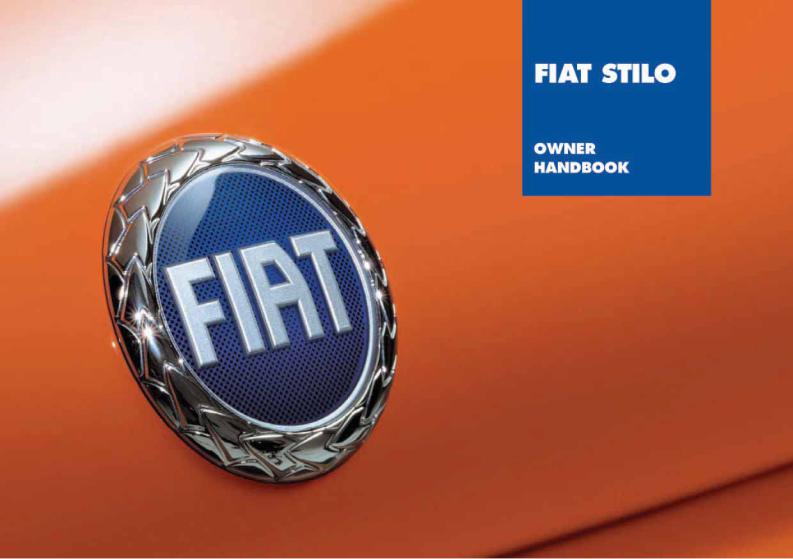
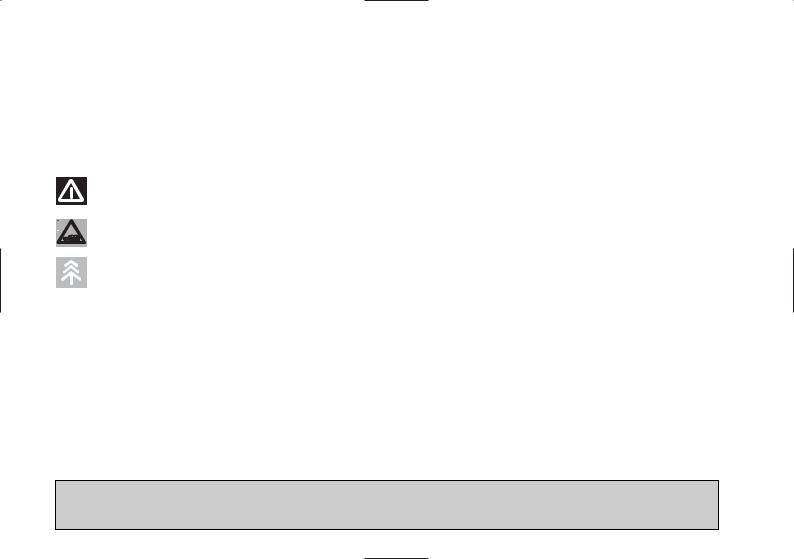
Dear Customer,
Thank you for selecting Fiat and congratulations on your choice of a Fiat Stilo.
We have written this handbook to help you get to know all your new Fiat Stilo features and use it in the best possible way. You should read it right through before taking the road for the first time.
You will find information, tips and important warnings regarding the driving of your car to help you derive the maximum from your Fiat Stilo technological features.
You are recommended to read carefully the warnings and indications, marked with the respective symbols, at the end of the page:
personal safety;
the car’s wellbeing;
environmental protection.
The enclosed Warranty Booklet lists the services that Fiat offers to its Customers:
the Warranty Certificate with terms and conditions for maintaining its validity
the range of additional services available to Fiat Customers.
Best regards and good motoring!
This Owner Handbook describes all Fiat Stilo versions. As a consequence, you should consider only the information which is related to the engine and bodywork version of the car you purchased.

MUST BE READ!
REFUELLING
Petrol engines: only refuel with unleaded petrol with octane rating (RON) not less than 95 conforming to the Eu-
Kropean specification EN 228.
Diesel engines: only refuel with diesel fuel conforming to the European specification EN590. The use of other products or mixtures may irreparably damage the engine with invalidation of the warranty due to the damage caused.
ENGINE STARTING
Petrol engines with mechanical gearbox: make sure that the handbrake is engaged; set the gearshift lever to neutral; fully depress the clutch without pressing the accelerator, then turn the ignition key to AVV and release it as soon as the engine has started.
Petrol engines with Selespeed gearbox: keep the brake pedal fully depressed; turn the ignition key to AVV and release it as soon as the engine has started; the transmission sets to neutral automatically.
Diesel engines: turn the ignition key to MAR and wait for the warning lights Yand m to go off; turn the ignition key to AVV and release it as soon as the engine has started.
PARKING ON FLAMMABLE MATERIAL
While working, the catalyst develops a very high temperature. Do not park the car over grass, dry leaves, pine needles or any other inflammable materials: risk of fire.
RESPECTING THE ENVIRONMENT
The car is fitted with a system that allows continuous diagnosis of the components correlated with emissions to ensure better respect for the environment.

ELECTRICAL ACCESSORIES
If, after buying the car, you decide to add electrical accessories (that will gradually drain the battery), visit a Fiat Dealership. They can calculate the overall electrical requirement and check that the car’s electric system can support the required load.
CODE card
Keep the code card in a safe place, not in the car. The code card shall be used for requesting additional keys.
SCHEDULED SERVICING
Correct maintenance of the car is essential for ensuring it stays in tip-top condition and safeguards its safety features, its environmental friendliness and low running costs for a long time to come.
THE OWNER HANDBOOK CONTAINS…
… information, tips and important warnings regarding the safe, correct driving of your car, and its maintenance. Pay particular attention to the symbols " (personal safety) # (environmental protection) ! (the car’s wellbeing).

DASHBOARD |
AND CONTROLS |
SAFETY |
DEVICES |
CORRECT USE |
OF THE CAR |
WARNING LIGHTS AND |
MESSAGES |
IN AN |
EMERGENCY |
CAR |
MAINTENANCE |
TECHNICAL |
SPECIFICATIONS |
|
INDEX |
DASHBOARD AND CONTROLS
DASHBOARD ........................................................................ |
5 |
INSTRUMENT PANEL ......................................................... |
6 |
SYMBOLS ................................................................................. |
8 |
THE FIAT CODE SYSTEM................................................... |
8 |
THE KEYS ................................................................................ |
10 |
ALARM ..................................................................................... |
17 |
IGNITION SWITCH.............................................................. |
20 |
INSTRUMENTS....................................................................... |
21 |
MULTIFUNCTION DISPLAY ............................................. |
23 |
TRIP COMPUTER ................................................................. |
34 |
SEATS ........................................................................................ |
37 |
HEAD RESTRAINTS .............................................................. |
41 |
STEERING WHEEL ............................................................... |
42 |
REARVIEW MIRRORS........................................................... |
43 |
HEATING/CLIMATE CONTROL SYSTEM .................... |
44 |
HEATING AND VENTILATION ....................................... |
46 |
MANUAL CLIMATE CONTROL SYSTEM .................... |
48 |
AUTOMATIC TWO-ZONE |
|
CLIMATE CONTROL SYSTEM ......................................... |
51 |
EXTERNAL LIGHTS .............................................................. |
57 |
WINDOW WASHING......................................................... |
60 |
CRUISE CONTROL ............................................................. |
64 |
CEILING LIGHTS .................................................................. |
67 |
CONTROLS ........................................................................... |
68 |
INTERIOR FITTINGS ............................................................ |
70 |
“SKYWINDOW”(BLADE SUNROOF) ........................... |
74 |
DOORS .................................................................................... |
79 |
POWER WINDOWS ........................................................... |
80 |
BOOT ........................................................................................ |
81 |
BONNET .................................................................................. |
92 |
ROOF RACK/SKI RACK ..................................................... |
93 |
HEADLIGHTS.......................................................................... |
94 |
ABS SYSTEM ........................................................................... |
95 |
ESP SYSTEM ............................................................................ |
97 |
EOBD SYSTEM ....................................................................... |
99 |
SOUND SYSTEM.................................................................... |
100 |
ACCESSORIES PURCHASED BY THE OWNER ......... |
101 |
“DUALDRIVE” ELECTRIC POWER |
|
STEERING SYSTEM .............................................................. |
102 |
PARKING SENSORS ............................................................ |
103 |
AT THE FILLING STATION .............................................. |
105 |
PROTECTING THE ENVIRONMENT ............................ |
108 |
4
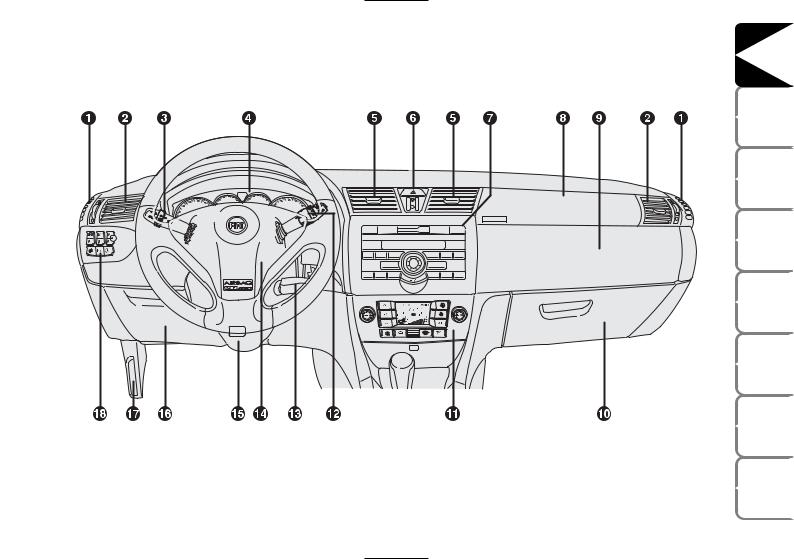
DASHBOARD
The presence and the position of the instruments and warning lights may vary according to the versions.
F0C0155m
fig. 1
1. Side window air vent - 2. Adjustable and swivel air vent - 3. External light stalk - 4. Instrument panel - 5. Adjustable and swivel air vent - 6. Hazard light switch - 7. Sound system controls - 8. Front passenger air bag - 9. Upper glovebox - 10. Lower glovebox - 11. Controls for heating, ventilation and climate control - 12. Windscreen/rear window wiper/trip computer stalk - 13. Ignition key and ignition switch - 14. Driver air bag - 15. Steering wheel locking/release stalk - 16. Control unit access door - 17. Bonnet opening lever - 18. Set of switches for lights and menu opening/setting.
DASHBOARD AND CONTROLS |
|
SAFETY |
DEVICES |
CORRECT USE |
OF THE CAR |
WARNING |
LIGHTS AND MESSAGES |
IN AN |
EMERGENCY |
CAR |
MAINTENANCE |
TECHNICAL |
SPECIFICATIONS |
INDEX |
|
5

DASHBOARD |
AND CONTROLS |
SAFETY |
DEVICES |
CORRECT USE |
OF THE CAR |
WARNING LIGHTS AND |
MESSAGES |
IN AN |
EMERGENCY |
CAR |
MAINTENANCE |
TECHNICAL |
SPECIFICATIONS |
|
INDEX |
INSTRUMENT PANEL
fig. 2
fig. 3
F0C0521m
F0C0522m
1.416V - 1.616V - 1.816V versions A Rev counter
BEngine coolant temperature gauge and excessive temperature warning light
CFuel level gauge with reserve warning light
D Speedometer (speed indicator)
E Multifunction display.
The rev counter of versions with Selespeed transmission is fitted with warning light t.
1.9 Multijet versions A Rev counter
BEngine coolant temperature gauge and excessive temperature warning light
CFuel level gauge with reserve warning light
D Speedometer (speed indicator)
E Multifunction display.
The rev counter of versions with Selespeed transmission is fitted with warning light t.
6
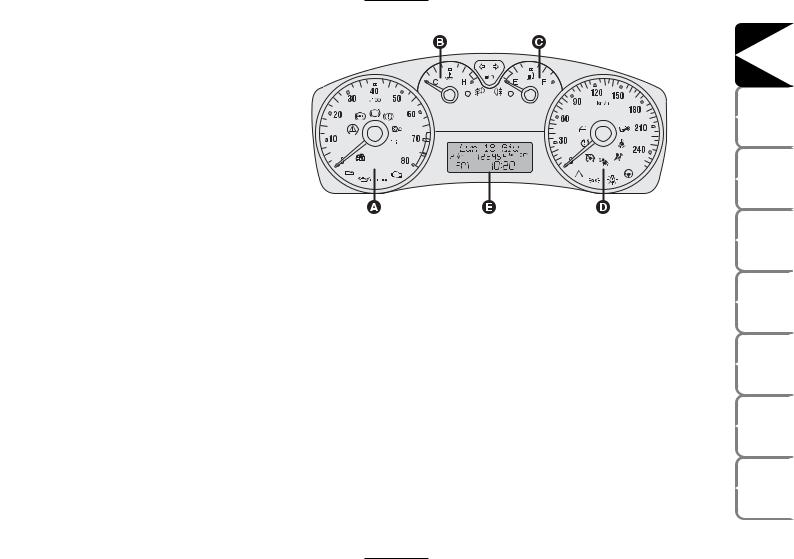
2.420V Selespeed Abarth versions A Rev counter
BEngine coolant temperature gauge and excessive temperature warning light
CFuel level gauge with reserve warning light
D Speedometer (speed indicator)
E Multifunction display.
fig. 4
DASHBOARD AND CONTROLS |
|
SAFETY |
DEVICES |
CORRECT USE OF THE CAR |
|
F0C0523m |
LIGHTS AND MESSAGES |
WARNING |
|
IN AN |
EMERGENCY |
CAR |
MAINTENANCE |
TECHNICAL |
SPECIFICATIONS |
INDEX |
|
7
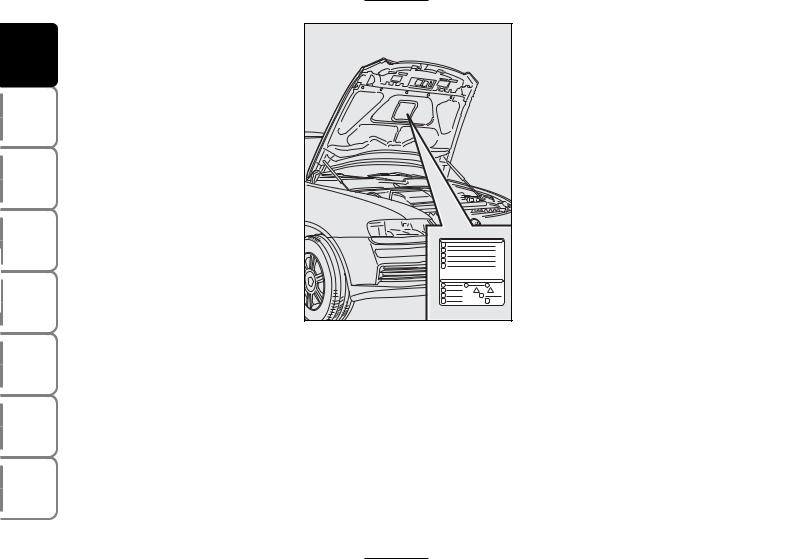
DASHBOARD |
AND CONTROLS |
SAFETY |
DEVICES |
CORRECT USE |
OF THE CAR |
WARNING LIGHTS AND |
MESSAGES |
IN AN |
EMERGENCY |
CAR |
MAINTENANCE |
TECHNICAL |
SPECIFICATIONS |
|
INDEX |
SYMBOLS
Special coloured labels have been attached near or actually on some of the components of your car. These labels bear symbols that remind you of the precautions to be taken as regards that particular component.
The plate summarising the symbols used can be found under the bonnet fig. 5.
fig. 5 |
F0C0145m |
|
THE FIAT CODE SYSTEM
To further protect you car from theft, it has been fitted with an engine immobilising system. This system is automatically activated when the ignition key is removed.
An electronic device, in fact, is fitted in each ignition key grip. The device transmits a radio-frequency signal when the engine is started through a special aerial built into the ignition switch. The modulate signal, which changes each time the engine is started, is the “password” by means of which the control unit recognises the key and enables to start the engine.
8
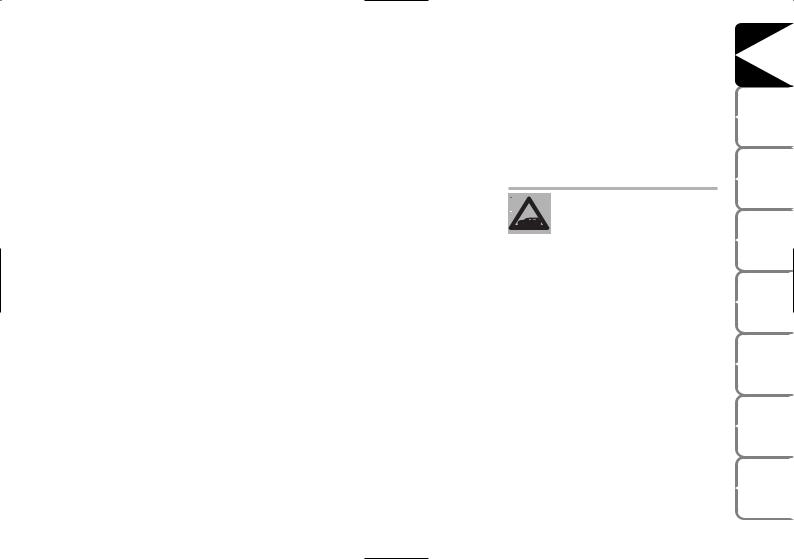
OPERATION
Each time the car is started turning the ignition key to MAR, the Fiat CODE system control unit sends a recognition code to the engine control unit to deactivate the inhibitor.
The code is sent only if the Fiat CODE system control unit has recognised the code transmitted from the key.
Each time the ignition key is turned to STOP, the Fiat CODE system deactivates the functions of the engine electronic control unit.
If the code has not been recognised correctly, the instrument panel warning light Ywill turn on.
In this case, the key should be moved to the STOP position and then back to MAR; if the lock continues, possibly try again with the other key provided with the car. If it is still not possible to start the car contact a Fiat Dealership.
IMPORTANT Every key has its own code, which must be memorised by the system control unit. To memorise new keys, up to a maximum of eight, apply solely to Fiat Dealership taking with you the CODE card and the keys, a personal identity document and the car’s ownership documents. The codes of the keys not provided during the new memorising procedure are erased from the memory. This is to ensure that any lost or stolen keys can no longer be used to start the car.
Warning light Ycoming on when driving
If the warning light Y turns on, this means that the system is running a selftest (for example for a voltage drop).
If the warning light Ycontinues to stay on, contact a Fiat Dealership.
The electronic components inside the key may be damaged if the key is submitted to sharp knocks.
DASHBOARD AND CONTROLS |
|
SAFETY |
DEVICES |
CORRECT USE |
OF THE CAR |
WARNING |
LIGHTS AND MESSAGES |
IN AN |
EMERGENCY |
CAR |
MAINTENANCE |
TECHNICAL |
SPECIFICATIONS |
INDEX |
|
9
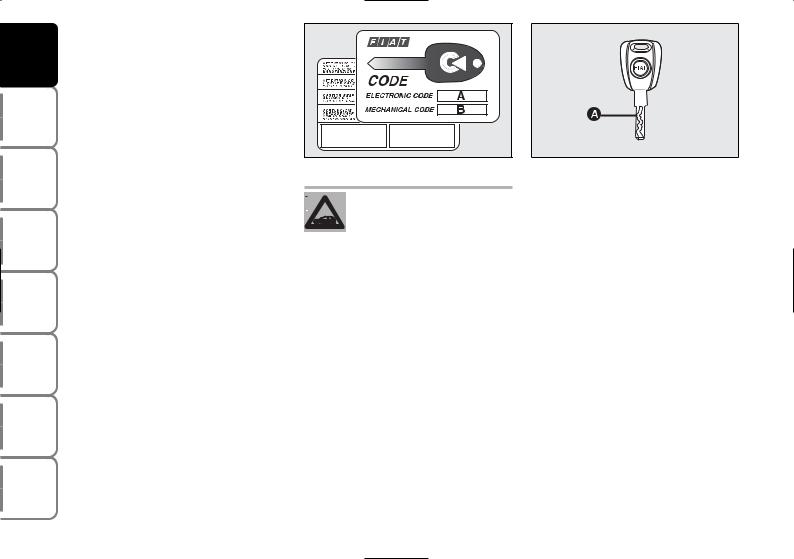
DASHBOARD |
AND CONTROLS |
SAFETY |
DEVICES |
CORRECT USE |
OF THE CAR |
WARNING LIGHTS AND |
MESSAGES |
IN AN |
EMERGENCY |
CAR |
MAINTENANCE |
TECHNICAL |
SPECIFICATIONS |
|
INDEX |
THE KEYS
CODE CARD
Together with the keys you will receive the CODE card fig. 6 to be presented to Fiat Dealership when requesting additional keys.
IMPORTANT In order to ensure perfect efficiency of the electronic devices contained inside the keys, they should never be exposed to direct sunlight.
fig. 6 |
F0C0001m |
fig. 7 |
F0C0508m |
|
|
All the keys and the CODE card must be handed over to the new owner when selling the car.
KEY WITHOUT REMOTE CONTROL (where provided)
The key is fitted with a metal insert A- fig. 7, operating:
the ignition switch
doors and tailgate locks
the fuel lid locking/unlocking (on versions featuring fuel filler cap with lock)
windows and Skywindow sunroof (where provided) opening/closing
the dead lock device (where provided)
the switch to deactivate the passenger’s air bag and rear side bags (where provided).
10
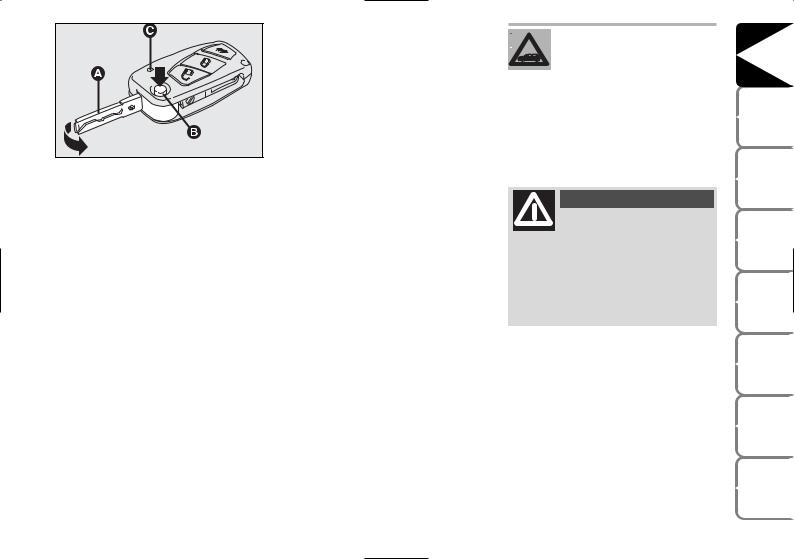
fig. 8 |
F0C0327m |
|
KEY WITH REMOTE CONTROL
The key is fitted with a metal insert A- fig. 8, operating:
the ignition switch
doors and tailgate locks
the fuel lid locking/unlocking (on versions featuring fuel filler cap with lock)
windows and Skywindow sunroof (where provided) opening/closing
the dead lock device (where provided)
the switch to deactivate the passenger’s air bag and rear side bags (where provided).
Button Ëfor remote unlocking of doors, tailgate and fuel filler cap. Button Áfor remote locking of doors, tailgate and fuel filler cap. Button R for remote opening of the tailgate. Button B for power-as- sisted opening of the metal insert A.
To refit the metal insert into the key grip, keep button B pressed and turn the metal insert in the direction shown by the arrow until hearing the click as it locks into place. Then release button B. Led C (where provided) comes on when sending the control to the alarm system receiver. To know the operating logics of the key with remote control and every possible and modifiable setting, see paragraph “Alarm” in this section.
If locking button Áis inadvertently pressed from the passenger compartment, when
getting out of the car only the doors being used will unlock; the tailgate will stay locked. To realign the system, press again the locking/unlocking buttons Á/ Ë.
WARNING
Button B-fig. 8 should only be pressed when the key is away from the body, in particular
from the eyes and from objects that can be spoilt (e.g. clothes). Make sure the key can never be touched by others, especially children, who may inadvertently press the button.
DASHBOARD AND CONTROLS |
|
SAFETY |
DEVICES |
CORRECT USE |
OF THE CAR |
WARNING |
LIGHTS AND MESSAGES |
IN AN |
EMERGENCY |
CAR |
MAINTENANCE |
TECHNICAL |
SPECIFICATIONS |
INDEX |
|
11

DASHBOARD |
AND CONTROLS |
SAFETY |
DEVICES |
CORRECT USE |
OF THE CAR |
WARNING LIGHTS AND |
MESSAGES |
IN AN |
EMERGENCY |
CAR |
MAINTENANCE |
TECHNICAL |
SPECIFICATIONS |
|
INDEX |
fig. 9 |
F0C0408m |
|
Opening the doors and the tailgate
Briefly press button Ë for remote unlocking of doors and tailgate and simultaneous alarm (where provided) deactivation, timed switching on of the internal ceiling lights and double flashing of direction indicators (for versions/markets where applicable).
Press button Ë for more than 2 seconds to open the windows and the Skywindow (where provided).
For Multi Wagon versions, pressing twice rapidly button R will open the rear window lid (where provided).
Once doors are unlocked, if you do not open one door or the tailgate within few seconds, the system will lock all doors/tailgate again automatically.
Doors will be unlocked automatically if the fuel inertial cut-off switch comes into operation.
Locking the doors and the tailgate
Briefly press button Á for remote locking of doors and tailgate and simultaneous alarm (where provided) activation, switching off of the internal ceiling lights and single flashing of direction indicators.
Press button Áfor more than 2 seconds to open the windows and the Skywindow (where provided). If the button is briefly pressed twice, the dead lock device is activated (see next paragraph “Dead lock device”).
If one or more doors are open locking will not be activated and the door led A-fig. 11 and direction indicators will flash rapidly. If only the tailgate is open the doors will lock.
12
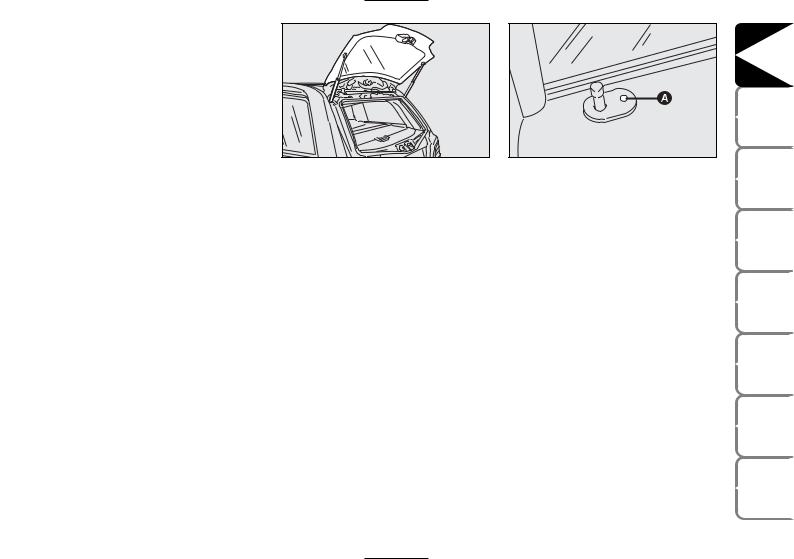
Opening the tailgate by the remote control
Press and keep button R pressed to open the tailgate by remote control even if the alarm (where provided) is on.
Opening the tailgate is accompanied by the direction indicators flashing twice; closing is accompanied by a single flash only if the alarm is on.
If the alarm is on, when the tailgate is opened the alarm system switches off volumetric protection and the tailgate perimetral protection sensor.
IMPORTANT If the remote control does not work properly, it is still possible to carry out the above mentioned operations by using the metal insert of the key.
When closing the tailgate again, volumetric and perimetral protection sensors are restored.
fig. 10 |
F0C0414m |
|
Opening the rear heated window lid (MultiWagon versions)
On MultiWagon versions, pressing twice button R rapidly, obtains opening of the rear heated window lid (see fig. 10).
|
DASHBOARD AND CONTROLS |
||
|
SAFETY |
DEVICES |
|
fig. 11 |
F0C0138m |
|
|
CORRECTUSE OF THE CAR |
|||
Leds on the driver’s door |
|||
|
|||
When locking the doors, led A-fig. 11 |
WARNING |
ANDLIGHTS MESSAGES |
|
switches on for about 3 seconds and than |
|||
|
|
||
starts flashing (deterrence function). |
|
|
|
Once doors are locked, if one or more |
|
|
|
doors or the tailgate are not closed cor- |
ANIN |
EMERGENCY |
|
rectly, the led and direction indicators |
|||
start flashing quickly. |
|
|
|
|
CAR |
MAINTENANCE |
|
|
TECHNICAL |
SPECIFICATIONS |
|
|
INDEX |
|
13
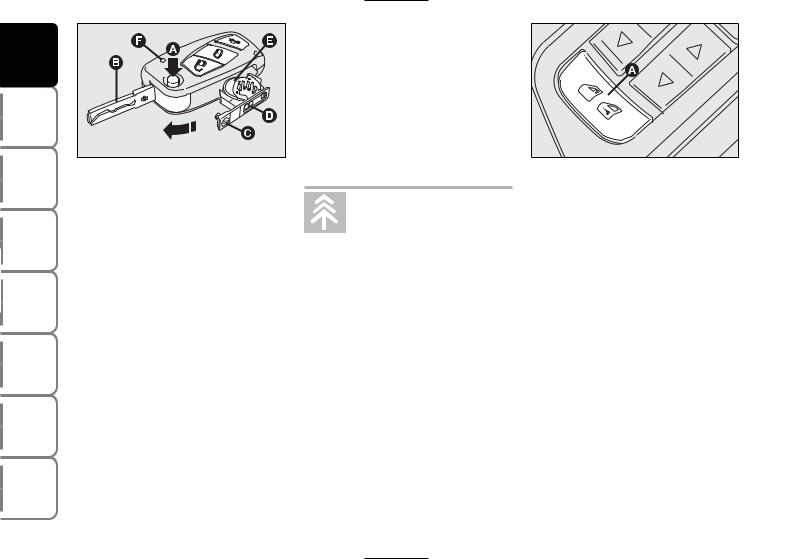
DASHBOARD |
AND CONTROLS |
SAFETY |
DEVICES |
CORRECT USE |
OF THE CAR |
WARNING LIGHTS AND |
MESSAGES |
IN AN |
EMERGENCY |
CAR |
MAINTENANCE |
TECHNICAL |
SPECIFICATIONS |
|
INDEX |
|
14 |
fig. 12 |
F0C0037m |
|
Request for additional remote controls
The system can recognise up to 8 remote controls. Should a new remote control be necessary, contact a Fiat Dealership, taking with you the CODE card, a personal identity document and the car’s ownership documents.
fig. 13 |
F0C0142m |
|
Replacing the battery of the key with remote control
If, when pressing button Ë, Á, or R, the led F-fig. 12 (where provided) on the key flashes briefly only once, the battery should be replaced with an equivalent one that can be purchased at common stores.
Battery replacement:
press button A and move the metal insert B to open position;
turn the screw C to : using a fine bit screwdriver;
take out the battery case D and replace the battery E making sure that the bias is correct;
re-insert the battery holder D in the
key and lock it turning the screw C to
;.
Used batteries are harmful to the environment. They should be disposed of as specified by law in the special containers
provided, or take them to a Fiat Dealership, which will deal with their disposal.
DEAD LOCK DEVICE (where provided)
This safety device enables to inhibit:
door internal handles and safety lock button;
button A-fig. 13 for locking/unlocking the doors, placed on the driver door panel mask;
thus hindering doors opening from inside the passenger’s compartment in case of attempt to break-into (e.g. window breaking).
The dead lock device guarantees the best protection against unwanted access. Therefore, it should be actuated every time the car is parked and left unattended.
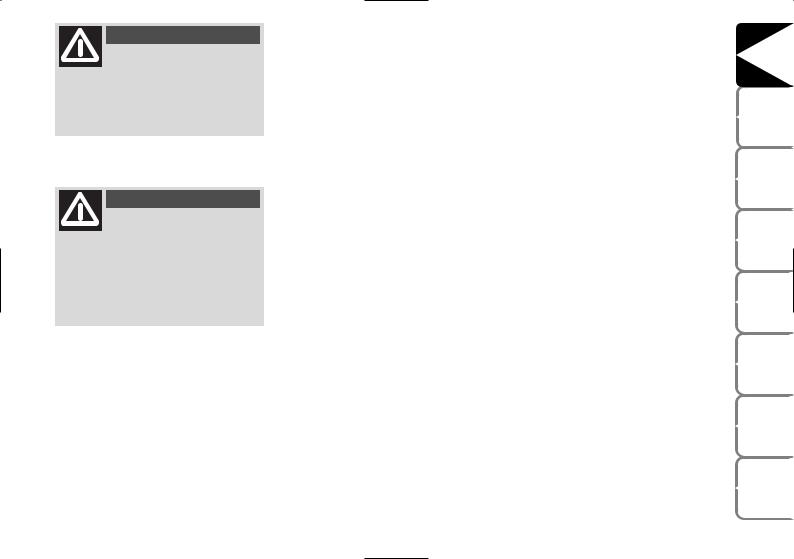
WARNING
Once the dead lock device has been actuated, doors cannot be opened from inside the car
in any way whatsoever. For this reason, make sure there are no persons left inside the car.
WARNING
If the battery of the key with remote control is down, the dead lock device can only be activat-
ed through the metal insert of the key in the revolving plugs of the doors as described previously: in this case the dead lock device is active only on the rear doors.
Device activation
The device is automatically activated on every door in the following cases:
turning twice the key without remote control (where provided) in closing direction;
pressing twice button Áof the key with remote control.
Device activation is signalled by three flashings of the direction indicators and flashing of the led on the driver door panel (see the table on next page).
If one of the doors is not perfectly closed, the dead lock device will not activate, thus preventing that a person getting into the car from the open door remains blocked inside the passenger’s compartment when she/he closes the door.
Device deactivation
The device is deactivated automatically on every door in the following cases:
when unlocking the doors;
when unlocking only the driver’s door;
when turning the ignition key to MAR.
DASHBOARD AND CONTROLS |
|
SAFETY |
DEVICES |
CORRECT USE |
OF THE CAR |
WARNING |
LIGHTS AND MESSAGES |
IN AN |
EMERGENCY |
CAR |
MAINTENANCE |
TECHNICAL |
SPECIFICATIONS |
INDEX |
|
15
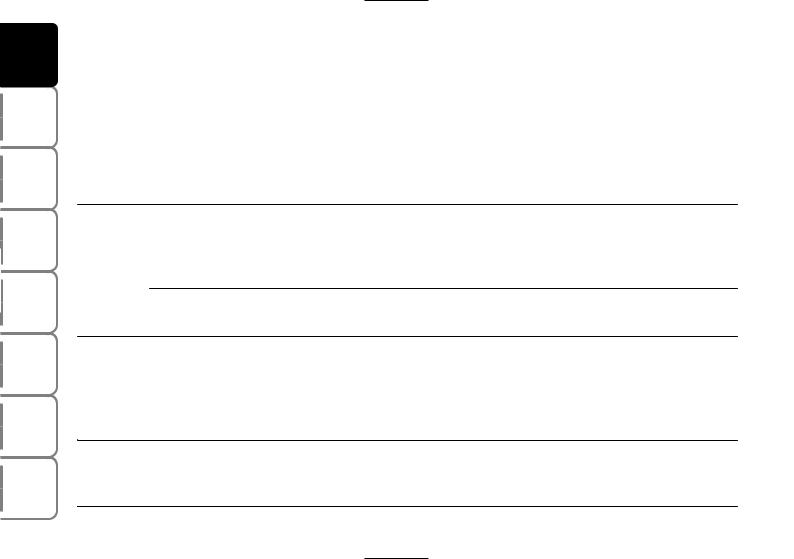
DASHBOARD |
AND CONTROLS |
SAFETY |
DEVICES |
CORRECT USE |
OF THE CAR |
WARNING LIGHTS AND |
MESSAGES |
IN AN |
EMERGENCY |
CAR |
MAINTENANCE |
TECHNICAL |
SPECIFICATIONS |
|
INDEX |
The main functions that can be activated with the keys (with or without remote control) are the following:
Type of |
|
Door opening |
|
Door closing |
|
Window and |
|
Window and |
|
Dead lock |
|
Tailgate |
key |
|
|
|
|
|
Skywindow |
|
Skywindow |
|
(where |
|
|
|
|
|
|
|
|
|
|
opening |
||||
|
|
|
|
|
|
opening (where |
|
closing (where |
|
provided) |
|
|
|
|
|
|
|
|
|
|
|
|
|||
|
|
|
|
|
|
provided) |
|
provided) |
|
|
|
|
Key without |
|
Key turning |
|
Key turning |
|
Turning (> 2 |
|
Turning (> 2 |
|
Double key rotation |
|
Key rotation |
remote |
|
counterclockwise |
|
clockwise |
|
seconds) in opening |
|
seconds) in closing |
|
in closing direction |
|
clockwise |
control |
|
(driver side) or |
|
(driver side) or |
|
position |
|
position (clockwise |
|
(clockwise driver |
|
|
(where |
|
clockwise |
|
counterclockwise |
|
(counterclockwise |
|
driver side; |
|
side; counterclock- |
|
|
provided) |
|
(passenger side) |
|
(passenger side) |
|
driver side; clock- |
|
counterclockwise |
|
wise passenger side) |
|
|
|
|
|
|
|
|
wise passenger side) |
|
passenger side) |
|
|
|
|
|
|
Key turning |
|
Key turning |
|
Turning (> 2 |
|
Turning (> 2 |
|
Double key rotation |
|
Key rotation |
|
|
counterclockwise |
|
clockwise |
|
seconds) in opening |
|
seconds) in closing |
|
in closing direction |
|
clockwise |
|
|
(driver side) or |
|
(driver side) or |
|
position (counter- |
|
position (clockwise |
|
(clockwise driver |
|
|
|
|
clockwise |
|
counterclockwise |
|
clockwise driver |
|
driver side; |
|
side; counterclock- |
|
|
Key with |
|
(passenger side) |
|
(passenger side) |
|
side; clockwise |
|
counterclockwise |
|
wise passenger side) |
|
|
|
|
|
|
|
passenger side) |
|
passenger side) |
|
|
|
|
|
remote |
|
|
|
|
|
|
|
|
|
|
||
|
Pressing briefly |
|
Brief press on |
|
Prolonged pressing |
|
Prolonged pressing |
|
Double pressing on |
|
Prolonged press- |
|
control |
|
|
|
|
|
|
||||||
|
|
button Ë |
|
button Á |
|
(> 2 seconds) on |
|
(> 2 seconds) on |
|
button Á |
|
ing (> 2 seconds) |
|
|
|
|
|
|
button Ë |
|
button Á |
|
|
|
on button R |
Direction |
|
Two flashings |
|
1 flashing |
|
Two flashings |
|
1 flashing |
|
3 flashings |
|
Two flashings |
indicators |
|
|
|
|
|
|
|
|
|
|
|
|
flashing |
|
|
|
|
|
|
|
|
|
|
|
|
(only with |
|
|
|
|
|
|
|
|
|
|
|
|
key with |
|
|
|
|
|
|
|
|
|
|
|
|
remote |
|
|
|
|
|
|
|
|
|
|
|
|
control) |
|
|
|
|
|
|
|
|
|
|
|
|
Led on |
|
Deterrence led |
|
Turned on fixed for |
|
Turning off |
|
Deterrence led |
|
Double flashing and |
|
Deterrent led |
driver door |
|
turning off |
|
approx. 3 seconds |
|
deterrence led |
|
flashing |
|
then deterrent led |
|
flashing |
|
|
|
|
and followed by de- |
|
|
|
|
|
flashing |
|
|
|
|
|
|
terrence led flashing |
|
|
|
|
|
|
|
|
|
|
|
|
|
|
|
|
|
|
|
|
|
16

ALARM
(where provided)
The alarm function is provided in addition to all remote control functions previously described and it is controlled by the receiver located under the dashboard, next to the fuse box.
WHEN THE ALARM IS
TRIGGERED
The alarm comes into action in the following cases:
unlawful opening of one of the doors, bonnet or boot (perimetral protection);
attempt to start the engine (turning the ignition key to MAR);
battery cable cutting;
presence of moving bodies in the passenger’s compartment (volumetric protection);
abnormal raising/sloping of the car.
Depending on the markets, the cutting in of the alarm causes operation of the siren and direction indicators (for about 26 seconds). The ways of operating and the number of cycles may vary depending on the markets.
A maximum number of sound/sight cycles is however envisaged.
Volumetric and anti-raising protections can be cut off by operating the front ceiling light controls (see paragraphs “Volumetric protection sensors” and “Anti-rais- ing sensor” on the following pages).
IMPORTANT The engine immobiliser function is guaranteed by the Fiat CODE system, which is automatically activated when the ignition key is removed.
HOW TO ACTIVATE THE ALARM
With the doors, bonnet and boot shut and the ignition key in the STOP position or with the key removed, point the key with remote control in the direction of the car, then press and release the button Á.
With the exception of certain markets, the system sounds a “beep” and the doors are locked.
Engagement of the alarm is preceded by a self-diagnostic test. If a fault is detected the system sounds a further warning “beep” and the display shows the relevant message (see section “Warning lights and messages”).
In this case, switch the alarm system off by pressing button Ë, check that the doors, bonnet and tailgate are properly shut, then switch the alarm on again by pressing button Á.
Otherwise, the door, bonnet or tailgate that is not shut properly will be excluded from the alarm system control.
DASHBOARD AND CONTROLS |
|
SAFETY |
DEVICES |
CORRECT USE |
OF THE CAR |
WARNING |
LIGHTS AND MESSAGES |
IN AN |
EMERGENCY |
CAR |
MAINTENANCE |
TECHNICAL |
SPECIFICATIONS |
INDEX |
|
17
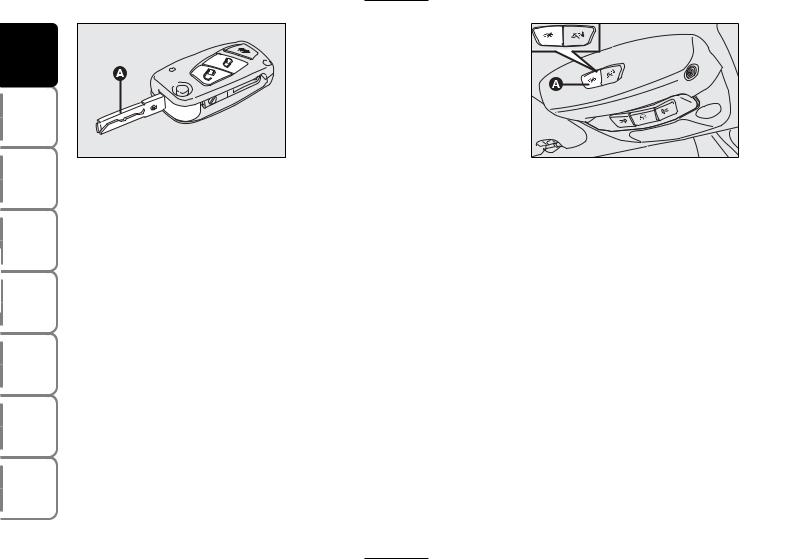
DASHBOARD |
AND CONTROLS |
SAFETY |
DEVICES |
CORRECT USE |
OF THE CAR |
WARNING LIGHTS AND |
MESSAGES |
IN AN |
EMERGENCY |
CAR |
MAINTENANCE |
TECHNICAL |
SPECIFICATIONS |
|
INDEX |
fig. 14 |
F0C0335m |
|
If the doors, bonnet and boot are shut correctly and the control signal is repeated, the system self-diagnostics has detected a system operating fault. It is therefore necessary to contact Fiat Dealership.
IMPORTANT When operating the central door locking with the metal insert A- fig. 14 of the key, the alarm is not activated.
IMPORTANT The electronic alarm is built in compliance with the law and regulations of the different countries.
HOW TO DEACTIVATE THE ALARM
Press button Ë of the key with remote control.
The system will react as follows (with the exception of certain markets):
two brief flashes of the direction indicators;
two brief “beeps”;
door unlocking.
IMPORTANT Operating the central door locking with the metal insert of the key will not deactivate the alarm.
VOLUMETRIC PROTECTION SENSORS
The volumetric sensors are inside the front ceiling light in the passenger’s compartment. To make sure that the volumetric sensors are working properly, check that doors, boot, bonnet, windows and Skywindow (where provided) are shut.
fig. 15 |
F0C0286m |
|
Volumetric protection deactivation
If it is necessary to switch on the alarm when animals or people are in the car, press button A-fig. 15 on the front ceiling light to deactivate the volumetric protection.
Deactivation is needed also in the presence of additional independent heater and when it is switched on with the remote control.
Protection cut-out stays on until activating the central door opening again.
18
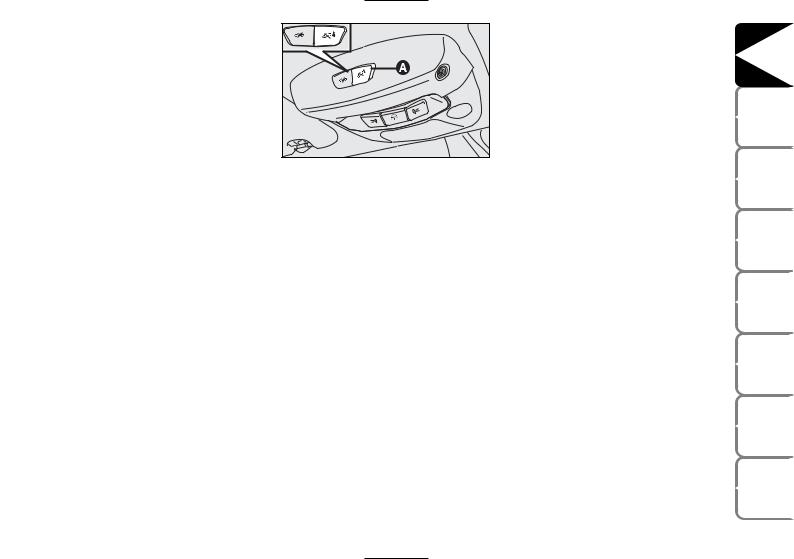
ANTI-RAISING SENSOR
The anti-raising sensor detects any abnormal car raising/sloping, even partial (e.g.: attempt to remove a wheel).
This sensor can detect the smallest car sideslip angle changes, both longitudinally and transversally.
Sideslip angle changes lower than 0.5°/min. (e.g.: slow tyre flattening) are not considered.
fig. 16 |
F0C0287m |
|
Anti-raising protection deactivation
To deactivate the anti-raising protection (for example when towing the car with alarm on) press button A-fig. 16 on the front ceiling light. Sensor cut-out stays on until activating the central door opening again.
INDICATIONS OF ATTEMPTS TO BREAK IN
Any attempt to break in is indicated by warning light Yon the instrument panel with the relevant message on the display (see section “Warning lights and messages”).
HOW TO CUT OFF THE ALARM SYSTEM
To deactivate the alarm system completely (for instance during prolonged inactivity of the car) simply lock the car turning the metal insert of the key with remote control in the lock.
IMPORTANT To cut-out the electronic alarm if remote control batteries are down or the system is failing, fit the key into the ignition switch and turn it to
MAR.
DASHBOARD AND CONTROLS |
|
SAFETY |
DEVICES |
CORRECT USE |
OF THE CAR |
WARNING |
LIGHTS AND MESSAGES |
IN AN |
EMERGENCY |
CAR |
MAINTENANCE |
TECHNICAL |
SPECIFICATIONS |
INDEX |
|
19
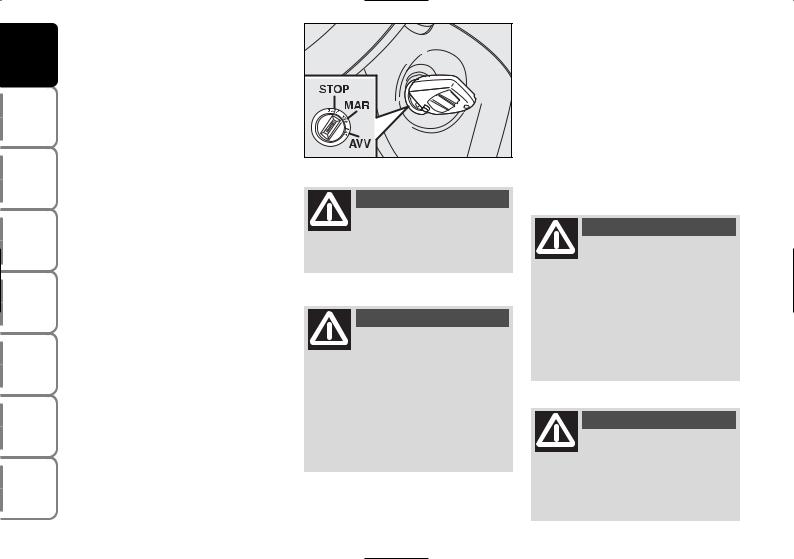
DASHBOARD |
AND CONTROLS |
SAFETY |
DEVICES |
CORRECT USE |
OF THE CAR |
WARNING LIGHTS AND |
MESSAGES |
IN AN |
EMERGENCY |
CAR |
MAINTENANCE |
TECHNICAL |
SPECIFICATIONS |
|
INDEX |
IGNITION SWITCH
The key can be turned to 3 different positions:
STOP: engine off, key can be removed, steering column locked. Certain electrical devices (e.g.: sound system, central door locking, electronic alarm, etc.) can work.
MAR: driving position. All electrical devices are powered.
AVV: engine starting.
The ignition switch is fitted with a safety mechanism that, in the event the engine is not started, compels the driver to turn the ignition key back to STOP before repeating the starting operation.
fig. 17 |
F0C0164m |
|
WARNING
If the ignition device is tampered with (e.g.: attempted theft), have it checked over by a Fiat
Dealership before restarting to drive.
WARNING
When getting out of the car, always remove the key to prevent any occupants from accidentally activating the controls. Remember to engage the handbrake and if the car is parked on uphill slope to engage the first gear. If the car is facing downhill, engage the reverse gear. Never leave unsupervised chil-
dren in the car.
STEERING COLUMN LOCK
Engaging
When the key is at STOP remove the key and turn the steering wheel until it locks.
Disengaging
Rock the steering wheel slightly as you turn the ignition key to MAR.
WARNING
It is absolutely forbidden to carry out whatever aftermarket operation involving steering
system or steering column modifications (e.g.: installation of anti-theft device) that could badly affect performance and safety, cause the lapse of warranty and also result in noncompliance of the car with homologation requirements.
WARNING
Never remove the ignition key while the car is moving.
The steering wheel would automatically lock as soon as you try to turn it. This also applies when the car is being towed.
20

INSTRUMENTS
|
|
|
|
|
|
|
|
|
|
|
|
|
|
fig. 18 |
F0C0530m |
fig. 18a |
F0C0527m |
|||
|
|
|||||
SPEEDOMETER fig. 18 |
|
REV. COUNTER fig. 18a |
|
|||
It shows the car speed. |
|
The rev counter shows engine rpm. The |
||||
|
|
needle pointed to the red area (danger) |
||||
|
|
indicates excessive high engine speed. Do |
||||
|
|
not drive for long periods with the needle |
||||
|
|
in this area. |
|
|||
IMPORTANT The electronic injection control system gradually shuts off the flow of fuel when the engine is “over-revving” resulting in a gradual loss of engine power.
When the engine is idling, the rev counter may indicate a gradual or sudden speed increase. This is normal as it takes place during normal operation, for example when activating the climate control system or the fan. In particular a slow change in the speed preserves the battery charge.
DASHBOARD AND CONTROLS |
|
SAFETY |
DEVICES |
CORRECT USE |
OF THE CAR |
WARNING |
LIGHTS AND MESSAGES |
IN AN |
EMERGENCY |
CAR |
MAINTENANCE |
TECHNICAL |
SPECIFICATIONS |
INDEX |
|
21
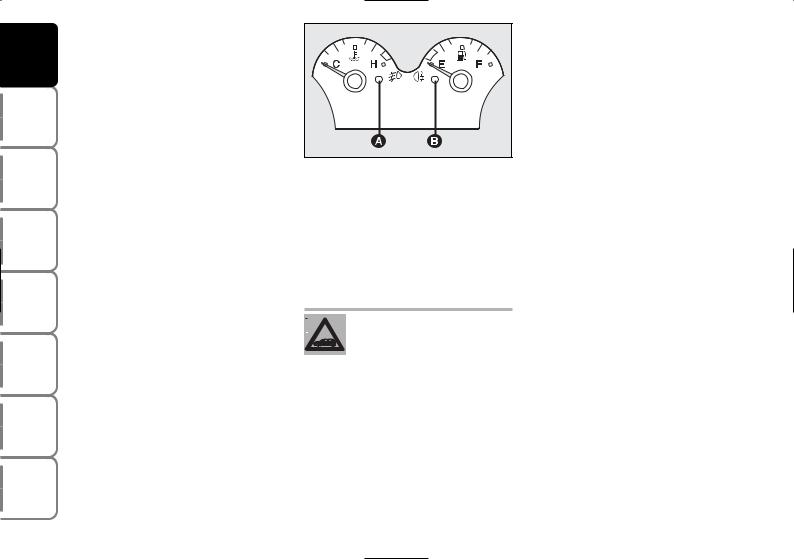
DASHBOARD |
AND CONTROLS |
SAFETY |
DEVICES |
CORRECT USE |
OF THE CAR |
WARNING LIGHTS AND |
MESSAGES |
IN AN |
EMERGENCY |
CAR |
MAINTENANCE |
TECHNICAL |
SPECIFICATIONS |
|
INDEX |
|
22 |
ENGINE COOLANT
TEMPERATURE GAUGE
This shows the temperature of the engine coolant fluid and begins working when the fluid temperature exceeds approx. 50°C.
Under normal conditions, the needle should move to different positions of the scale according to the conditions of use of the car.
C - Low engine coolant temperature.
H - High engine coolant temperature.
fig. 19 |
F0C0528m |
|
The turning on of the warning light A-fig. 19 (together with the message shown on the display) indicates that the coolant fluid temperature is too high; in this case, stop the engine and contact a Fiat Dealership.
If the needle reaches the red area, stop the engine immediately and contact a Fiat Dealership.
FUEL LEVEL GAUGE
This shows the amount of fuel left in the fuel tank.
The reserve warning light B- fig. 19 turns on to indicate that approx. 8 litres of fuel are left in the tank.
E - tank empty.
F - tank full (see the indications given in paragraph “At the filling station").
Do not travel with the fuel tank almost empty: the gaps in fuel delivery could damage the catalyst.
IMPORTANT If the needle sets at E with warning light B flashing, it means that the system is malfunctioning. Contact a Fiat Dealership to have the system inspected.
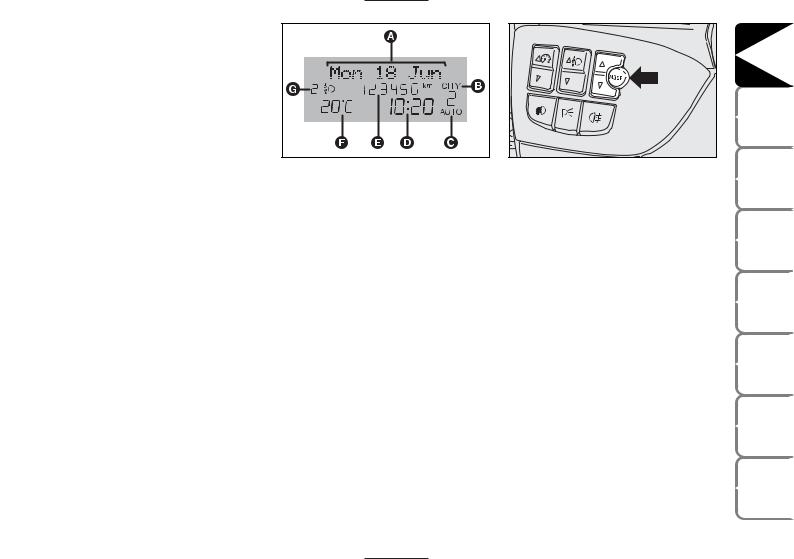
MULTIFUNCTION
DISPLAY
Your car is fitted with the multifunction display that shows all the useful information necessary when driving.
INFORMATION ON “STANDARD” SCREEN fig. 20
The standard screen shows the following indications:
A Date
BDualdrive electric power steering engagement, if any
CSelespeed mode (where provided) and engaged gear display
D Clock
E Odometer (covered km or miles)
F External temperature
G Headlight aiming position (only with dipped beam headlights on)
fig. 20 |
F0C3245g |
|
CONTROL BUTTONS fig. 21
ÕTo scroll the display and the related options upwards or to increase the value displayed.
MODE Brief press to open the menu and/or to move to next screen or to confirm the option required.
Long press to go back to the standard screen.
ÔTo scroll the display and the related options downwards or to decrease the value displayed.
fig. 21 |
F0C0022m |
|
Note Buttons Õand Ôactivate different functions according to the following situations:
–to scroll the menu options upwards and downwards;
–to increase or to decrease values during settings.
DASHBOARD AND CONTROLS |
|
SAFETY |
DEVICES |
CORRECT USE |
OF THE CAR |
WARNING |
LIGHTS AND MESSAGES |
IN AN |
EMERGENCY |
CAR |
MAINTENANCE |
TECHNICAL |
SPECIFICATIONS |
INDEX |
|
23

DASHBOARD |
AND CONTROLS |
SAFETY |
DEVICES |
CORRECT USE |
OF THE CAR |
WARNING LIGHTS AND |
MESSAGES |
IN AN |
EMERGENCY |
CAR |
MAINTENANCE |
TECHNICAL |
SPECIFICATIONS |
|
INDEX |
SETUP MENU fig. 22
The menu comprises a series of functions arranged in a “circular fashion” which can be selected through buttons Õ and Ô to access the different select operations and settings (setup) given below. For certain options (Set time and Units) there is a submenu.
The setup menu can be activated by pressing briefly button MODE.
Single presses on buttons Õ or Ô will scroll the setup menu options. Handling modes differ with each other according to the characteristic of the option selected.
Note If the car is equipped with Connect/Navigator, phone and audio info can be repeated on the multifunction display. For other set-up menu adjustments and/or settings, see the Connect/Navigator Supplement.
Selecting an option in the main menu without submenu:
–press briefly button MODE to select the menu option to set;
–press buttons Õ or Ô (by single presses) to select the new setting;
–press briefly button MODE to store the new setting and to go back to the previously selected menu option.
Selecting an option in the main menu with submenu:
–press briefly button MODE to display the first submenu option;
–press buttons Õ or Ô (by single presses) to scroll all submenu options;
–press briefly button MODE to select the displayed submenu option and to enter the relevant setup menu;
–press buttons Õ or Ô (by single presses) to select the new setting;
–press briefly button MODE to store the new setting and to go back to the previously selected submenu option.
24

Selecting “Set date” and “Set time”:
–briefly press button MODE to select the first value to change (e.g. hours /minutes or year / month / day);
–press buttons Õ or Ô (by single presses) to select the new setting;
–briefly press button MODE to store the new setting and to go to the next setup menu option, if this is the last one you will go back to the previously selected option of the main menu.
Press button MODE for long:
–to quit the submenu if you are at submenu option setting level;
–to quit the main menu if you are at submenu level;
–to quit the main menu if you are at main menu option setting level;
–to quit the set up menu if you are in the main menu;
–only settings stored yet by the user (and confirmed by pressing briefly button MODE) will be saved.
The setup menu displaying is timed; when quitting the menu due to timing expiry, only settings stored yet by the user (and confirmed by pressing briefly button MODE) will be saved.
DASHBOARD AND CONTROLS |
|
SAFETY |
DEVICES |
CORRECT USE |
OF THE CAR |
WARNING |
LIGHTS AND MESSAGES |
IN AN |
EMERGENCY |
CAR |
MAINTENANCE |
TECHNICAL |
SPECIFICATIONS |
INDEX |
|
25
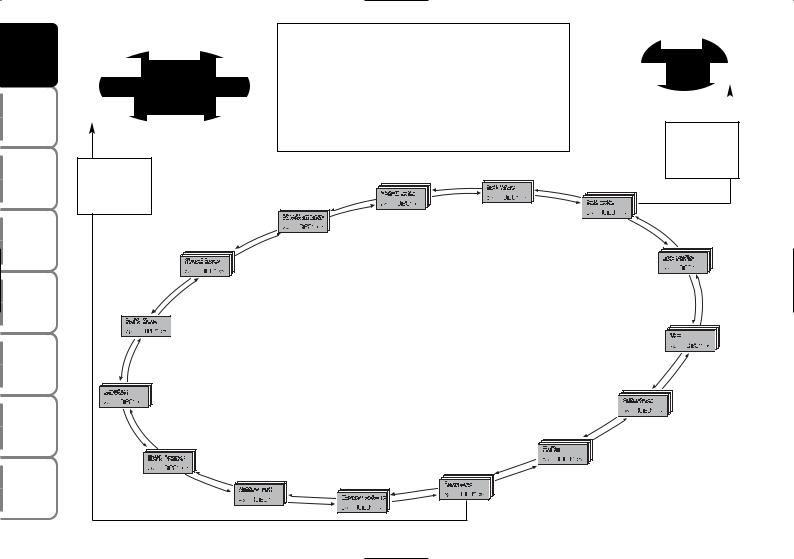
DASHBOARD |
AND CONTROLS |
SAFETY |
DEVICES |
CORRECT USE |
OF THE CAR |
WARNING LIGHTS AND |
MESSAGES |
IN AN |
EMERGENCY |
CAR |
MAINTENANCE |
TECHNICAL |
SPECIFICATIONS |
|
INDEX |
Example: |
|
Briefly press button MODE to start surfing from the standard |
|
Day |
||
|
Español |
|
||||
|
screen. To surf the menu use buttons Õor Ô. For safety rea- |
|
|
|||
Français |
Portuges |
sons, when the car is running, it is possible to access only the |
Year |
Month |
||
|
|
reduced menu (for setting the “Speed limit” and “Automatic |
||||
|
|
|
|
|||
Italiano |
Deutsch |
headlight sensor sensitivity adjustment” (where provided). |
|
|
||
When the car is stationary access to the whole menu is en- |
|
|
||||
|
English |
abled. On cars provided with Connect/Navigator many func- |
|
|
||
|
tions are displayed on the navigator display. |
|
MODE |
|||
|
|
|
||||
|
|
|
|
|
|
briefly press |
MODE |
|
|
|
|
|
button |
|
|
|
|
|
|
|
briefly press |
|
|
|
|
|
|
button |
|
|
|
|
|
|
|
|
|
TRIP B DATA |
SET TIME |
|
|
|
|
|
SET DATE |
|
|
|
|
|
HEADL. SENSOR |
|
|
||
|
|
|
|
|
||
|
|
|
|
SEE RADIO |
|
|
|
SPEED BEEP |
|
|
|
|
|
|
EXIT MENU |
|
|
|
|
|
|
|
|
|
|
KEY |
|
|
SERVICE |
|
|
AUTOCLOSE |
|
|
|
|
|
|
|
|
|
|
|
|
|
|
|
F0C2369g |
|
BELT BUZZER |
|
|
UNITS |
|
|
|
BUTTON VOL. |
LANGUAGE |
|
|
||
|
BUZZER VOLUME |
|
|
|
||
|
|
|
|
|
|
|
|
|
|
|
|
fig. 22 |
|
26

Speed limit (Speed Beep)
With this function it is possible to set the car speed limit (km/h or mph); when this limit is exceeded the driver is immediately alerted (see section “Warning lights and messages”).
To set the speed limit, proceed as follows:
–briefly press button MODE, the display will show wording (Speed Beep);
–press button Õ or Ô to select activation (On) or deactivation (Off) of the speed limit;
–if selecting (On), press button Õ or Ô to select the required speed limit and then press MODE to confirm.
Note The possible setting is between 30 and 250 km/h, or between 20 and 155 mph depending on the unit set previously (see paragraph “Distance unit (Distances)” described later. Every press on button Õ/Ô increases/decreases by 5 units. Keeping the button Õ/Ô pressed obtains the automatic fast increase or decrease. When you are near the required setting complete adjustment by single presses.
– briefly press button MODE to go back to the menu screen or press the button for long to go back to the standard screen without storing settings.
To abort the setting, proceed as follows:
–briefly press button MODE: (On) will flash on the display;
–press button Ô: (Off) will flash on the display;
–briefly press button MODE to go back to the menu screen or press the button for long to go back to the standard screen without storing settings.
Automatic headlight sensor sensitivity adjustment
(Headl. sensor) (where provided)
With this function it is possible to adjust the light sensor sensitivity according to 3 levels (level 1 = min. level, level 2 = average level, level 3 = max. level); the higher the sensitivity is, the lower is the external light intensity required to switch on the lights.
This operation can be performed also with the car moving.
To set the light level required, proceed as follows:
–briefly press button MODE, the previously set level will flash on the display;
–press button Õ or Ô to select the required level;
–briefly press button MODE to go back to the menu screen or press the button for long to go back to the standard screen without storing settings.
DASHBOARD AND CONTROLS |
|
SAFETY |
DEVICES |
CORRECT USE |
OF THE CAR |
WARNING |
LIGHTS AND MESSAGES |
IN AN |
EMERGENCY |
CAR |
MAINTENANCE |
TECHNICAL |
SPECIFICATIONS |
INDEX |
|
27

DASHBOARD |
AND CONTROLS |
SAFETY |
DEVICES |
CORRECT USE |
OF THE CAR |
WARNING LIGHTS AND |
MESSAGES |
IN AN |
EMERGENCY |
CAR |
MAINTENANCE |
TECHNICAL |
SPECIFICATIONS |
|
INDEX |
Trip B On/Off (TripB data)
Through this option it is possible to activate (On) or deactivate (Off) the Trip B (partial trip) (for further information see “Trip computer”).
For activation / deactivation, proceed as follows:
–briefly press button MODE: (On) or (Off) will flash on the display (according to previous setting);
–press button Õ or Ô for setting;
–briefly press button MODE to go back to the menu screen or press the button for long to go back to the standard screen without storing settings.
Setting the clock (Set time)
This function enables to set the clock through two submenus: “Time” and “Mode”.
To set the clock proceed as follows:
–briefly press button MODE, the display will show the two submenus “Time” and “Mode”;
–press button Õ or Ô to scroll the two submenus;
–select the required submenu and then press briefly MODE;
–if selecting “Time”: briefly press button MODE, “hours” will flash on the display;
–press button Õ or Ô for setting;
–press button MODE, “minutes” will flash on the display;
–press button Õ or Ô for setting.
–if selecting “Mode”: briefly press button MODE, “12h” or “24h” will flash on the display;
–press button Õor Ôto select “24h” or “12h”.
After setting, briefly press button MODE to go back to the submenu screen or press the button for long to go back to the main menu screen without storing settings.
– press again button MODE for long to go back to the standard screen or to the main menu according to the current menu level.
28

Setting the date (Set date)
This function enables to update the date (day – month – year).
To correct the date proceed as follows:
–briefly press button MODE: “year” will flash on the display;
–press button Õ or Ô for setting;
–briefly press button MODE: “month” will flash on the display;
–press button Õ or Ô for setting;
–briefly press button MODE: “day” will flash on the display;
–press button Õ or Ô for setting.
Note Every press on button Õ or Ô increases/decreases by 1 unit. Keeping the button pressed obtains automatic fast increase or decrease. When you are near the required setting complete adjustment by single presses.
– briefly press button MODE to go back to the menu screen or press the button for long to go back to the standard screen without storing settings.
Audio info repetition (See radio)
With this function the display repeats information relevant to the sound system.
–Radio: selected radio station frequency or RDS message;
–Audio CD/MP3 CD: CD and/or track number;
To activate (On) or to deactivate (Off) sound system info displaying proceed as follows:
–briefly press button MODE: (On) or (Off) will flash on the display (according to previous setting);
–press button Õ or Ô for setting;
–briefly press button MODE to go back to the menu screen or press the button for long to go back to the standard screen without storing settings.
Door opening mode (Key)
This function enables to select the required door opening mode:
–briefly press button MODE, the display will show the wording “Key”;
–press button Õ or Ô to select option “Open doors” or “Open all”;
–briefly press button MODE to go back to the menu screen or press the button for long to go back to the standard screen without storing settings.
–“Open doors”: press button Ëto open the doors (excluding the tailgate);
–“Open all”: press button Ëto open the doors and the tailgate.
DASHBOARD AND CONTROLS |
|
SAFETY |
DEVICES |
CORRECT USE |
OF THE CAR |
WARNING |
LIGHTS AND MESSAGES |
IN AN |
EMERGENCY |
CAR |
MAINTENANCE |
TECHNICAL |
SPECIFICATIONS |
INDEX |
|
29
